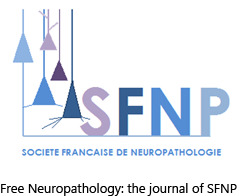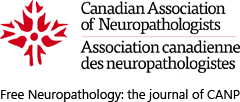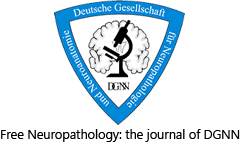Increased frontocortical microvascular raspberry density in frontotemporal lobar degeneration compared to Lewy body disease and control cases: a neuropathological study
DOI:
https://doi.org/10.17879/freeneuropathology-2025-6178Keywords:
Angiogenesis, Cerebrovascular disorders, Frontotemporal lobar degeneration, Lewy body disease, Neurodegenerative diseasesAbstract
Background: Brain raspberries are histologically defined microvascular entities that are highly prevalent in the neocortex. Increased cortical raspberry density occurs in vascular dementia, but also with advancing age. Here, we examined the raspberry density in two neurodegenerative diseases, wherein vascular alterations distinct from conventional vascular risk factors have been indicated: frontotemporal lobar degeneration (FTLD) and Lewy body disease (LBD).
Methods: This retrospective study included 283 clinically autopsied individuals: 105 control cases without neurodegenerative disease, 98 FTLD cases (mainly FTLD-tau and FTLD-TDP), and 80 LBD cases (mainly neocortical). The raspberry density was quantified on haematoxylin-eosin-stained tissue sections from the frontal cortex, and the frontocortical atrophy was ranked 0–3.
Results: There was a higher raspberry density in the FTLD group compared to both other groups (P ≤ 0.001; Games-Howell post hoc test). The difference between the FTLD and LBD groups remained significant in multiple linear regression models that included age, sex, and either brain weight (P = 0.034) or cortical atrophy (P = 0.012). The difference between the FTLD and control groups remained significant when including age, sex, and brain weight in the model (P = 0.004), while a trend towards significance was demonstrated when including age, sex, and cortical atrophy (P = 0.054). Further analyses of the FTLD group revealed a trend towards a positive correlation between raspberry density and cortical atrophy (P = 0.062; Spearman rank correlation). Comparisons of FTLD subgroups were inconclusive.
Conclusion: The frontocortical raspberry density is increased in FTLD. An examination of the raspberry density in relation to a quantitative measure of cortical atrophy is motivated to validate the results. Future studies are needed to determine whether increased raspberry density in FTLD could function as a marker for more widespread vascular alterations, and to elucidate the relation between microvascular alterations and neuro-degenerative disease.
Metrics
Published
How to Cite
Issue
Section
License
Copyright (c) 2025 Henric Ek Olofsson, Elisabet Englund

This work is licensed under a Creative Commons Attribution 4.0 International License.
Papers are published open access under the Creative Commons BY 4.0 license. This license lets others distribute, remix, adapt, and build upon your work, even commercially, as long as they credit you for the original creation. Data included in the article are made available under the CC0 1.0 Public Domain Dedication waiver, unless otherwise stated, meaning that all copyrights are waived.



















